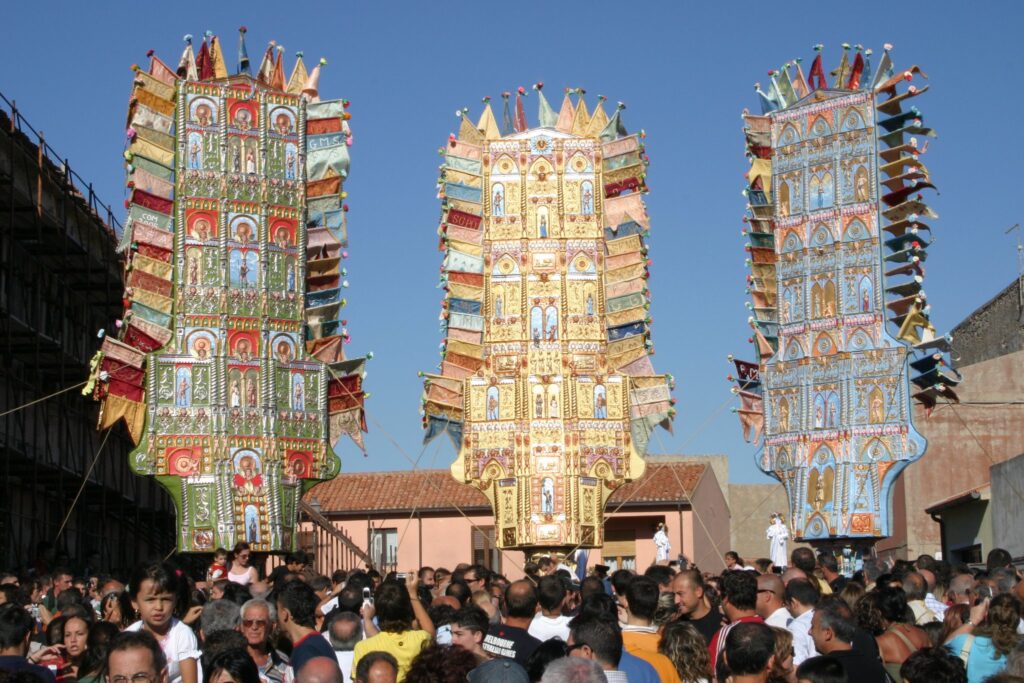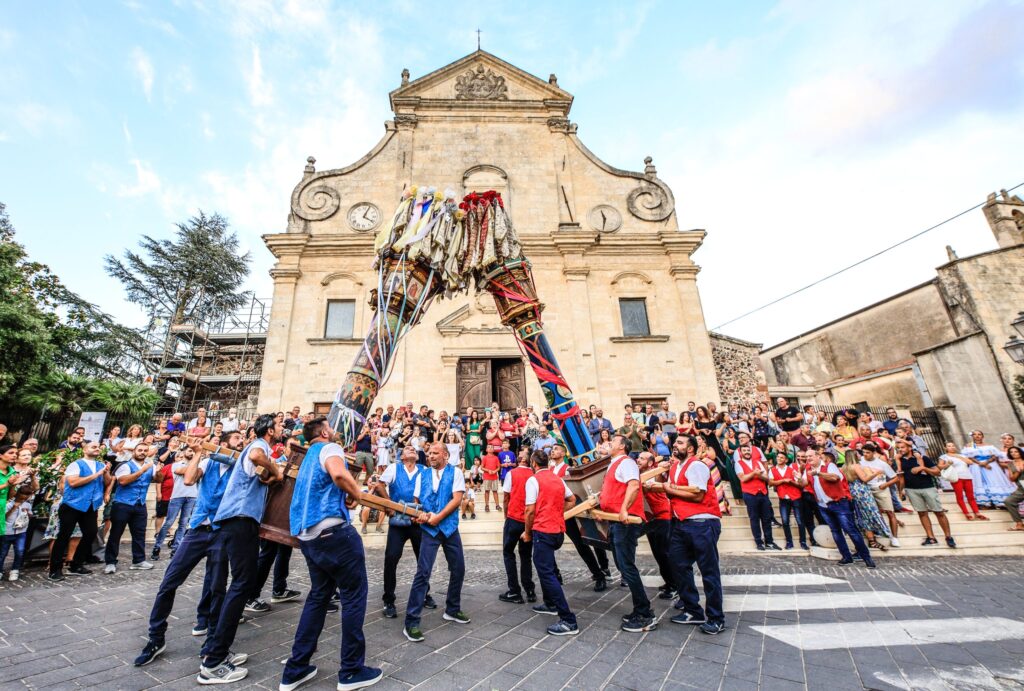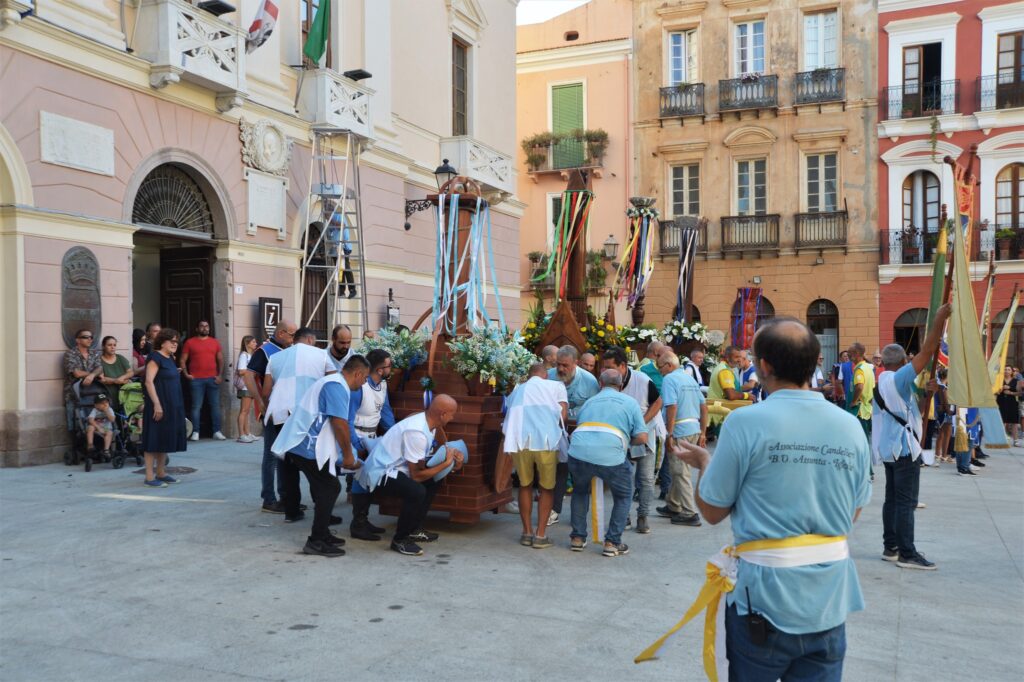✅ Introduction
Every summer, in the heart of August, Sardinia lights up with lights, colours and ancient melodies: it is the time of the Candelieri, solemn and spectacular votive processions that animate the streets of Sassari, Nulvi, Ploaghe and Iglesias. Although each community has its own rituals and details, the soul of these festivals is shared: the Marian devotion.
In this article, I take you on a journey through the four variants of the Candlestick tradition, comparing them and emphasising their symbolic and community value, at a time of year that renews the deepest identity of the Sardinian people.
✅ Sassari and the 'Festha Manna': the Faradda di li Candareri, or Descent of the Candlesticks.
🔹 Thirteen impressive wooden votive candlesticks, symbols of the ancient guilds of arts and crafts (the Gremi), each 14 august are carried on the shoulders along the streets of the historic centre, by Piazza Castello until the Church of St. Mary of Bethlehem. This solemn rite renews the vow to the Madonna Assunta, formulated in 1652 during the terrible plague epidemic that struck the city.
However, the candlestick tradition is older than the 1652 vow. Some scholars believe that the processional practice of candlesticks is of 14th-century or even 13th-century originbrought to Sardinia by the Republic of Pisa (where votive festivals with large candles and torches were widespread) and later influenced by Genoa.
🔹 The Rite of Candlestick Dressing, held in the morning of 14 August, is a symbolic moment of enormous significance. Each gremio decorates its candlestick with paper flowers, garlands, ribbons, ears of corn and colourful drapes, transforming it from a wooden object to a sacred symbol. It is a moment of ritual preparation and of strong community cohesion, in which the gremio meets in its own premises or at a votive chapel.
As historian Pierluigi Alotto observes:
"Dressing is the moment when the candlestick takes on its sacred and symbolic identity. From an inert body it becomes a sign of faith and history."
🔹 From here from early afternoon, around 4 p.m., the gremi with their representatives and bearers gather at the assembly point in Piazza Castello, from where the route starts, and after the thanksgiving mass, celebrated in the nearby Church of the Rosary, around 6 p.m., the descent down Corso Vittorio Emanuele begins.
The parade order proceeds from most recent at oldest: facchini (porters), macellai (butchers), fabbri (blacksmiths), piccapietre (stonecutters), viandanti (wayfarers), contadini (farmers), falegnami (carpenters), ortolani (greengrocers), calzolai (cobblers), sarti (tailors), muratori (bricklayers) (the latter two alternate each year in the order of descent) and Massai.
🔹 The Gremi, with their traditional clothes and historical insignia, are the real protagonists of the Faradda. Together with them, the crowd accompanies the procession with choirs, applause and shouts of incitement, turning the route into a collective dance of faith, toil and celebration..
More than a simple procession, the Faradda is the living expression of Sassarese's identity, handed down from generation to generation.
🔹 Since 2013, this extraordinary event is recognised as UNESCO Intangible Cultural Heritage of Humanity, as part of the Feste italiane dei Grandi Macchinari a Spalla, along with those of Viterbo, Nola and Palmi.

✅ Nulvi: Sa Essída, the strength of the community.
🔹 Every year, the 14 august, in the heart of Anglona, the village of Nulvi renews its most heartfelt tradition: Sa Essída de sos Candhaleris, the 'exit' of the Candlesticks. This is the most important religious and civil celebration in the country, dedicated to the Madonna Assunta, to which the community renews its devotion with a ceremony that combines spirituality, collective identity and popular art. The release of the three candlesticks constitutes the offering made to the Madonna by the population, in honour of a vow made to her at the time of the plague in 1200.
🔹 The stars of the party are three large Candlesticks, weighing around 9 quintals each, imposing vertical structures inspired by sacred iconography. Made of poor materials such as wood, reeds and papier-mâché, the candlesticks are transformed into veritable votive altarpieces adorned with sacred images and precious decorations in intense and symbolic colours:
- The green represents the shepherds, evoking the grassy pastures of the hinterland;
- The yellow recalls the golden ears of the fields cultivated by the Messai (the reapers);
- The blue of the Craftsmen's robes symbolises the sky, a colour that has always been linked to the Virgin Mary.
🔹 The celebration begins on the eve of 14 August, with preparations at the Oratory of San Filippo Neri, the spiritual centre of the organising confraternity. The feast proper opens with the blessing of the Candlesticks, which, carried on the shoulders of devotees, pass through the streets of the village accompanied by songs, prayers and the choral participation of the community.
At nightfall, the Candlesticks reach the parish church of the Assumption, where they are arranged in a circle around the simulacrum of the sleeping Virgin, strongly evoking the atmosphere of Byzantine liturgies. Here they will remain for eight days, as solemn guardians of the rite, while ceremonies, processions and moments of prayer follow one another.
🔹 Particularly striking is the presence of twelve brethren, dressed in ceremonial robes in oriental garb, who impersonate the Twelve Apostles in the context of the ancient rite of the 'Addormida', linked to the transit of Mary.
🔹 On the day of the Octave, the last act of the celebration, the Candlesticks are carried in procession back to the oratory of San Filippo Neri, where they will be kept until the following year. This ritual cycle, which preserves its archaic structure intact, represents one of the rare surviving examples of an integral octave ceremony still alive in contemporary Sardinia.

✅ Ploaghe: two candlesticks for two gremi.
🔹 In Ploaghe, the 15 August , a unique festivity is celebrated, centred around two historical Candlesticks, witnesses to a tradition spanning more than three centuries. The first documented traces date back to the vow issued by the local administration during the plague of 1580, as recalled by Rector Cossu.
The two Candlesticks, each consisting of a wooden pedestal about one metre high and a cylinder decorated with sacred images, carry the simulacra of the Child Jesus and St Peter, the city's patron saint, on top. A distinctive aspect is the double exit: the Candlesticks parade twice a year, on the day of Corpus Christi and on 15 August, accompanied by their respective octaves that include solemn services, new, more intimate and collected processions, and often cultural and musical events.
👉 The Octaves (in Sardinian: S'Ottava) are a traditional religious practice held eight days after a solemn feast, such as the celebration of the Assumption of the Virgin Mary on 15 August.
🔹 The 'obrieri' - called Candaleraju in Ploaghe - are four in number: two major ones, responsible for the main feasts, and two minor ones, who look after the octaves. They are appointed by lot, according to a historical agreement between the gremi of the Shepherds and the Messai.
The obrieri also organise 'su ziriu', a strip of silk embroidered in gold that is placed on the candle during the procession, and recruit the bearers, called 'sos de sutta'. The latter carry the candlesticks on their shoulders and do not receive monetary compensation, but a quarter of a sheep, a rich dinner and plenty of refreshments: an auspicious gesture for the whole community.
🔹 The colours of the flags reflect the social categories: red for the Shepherds and lighter shades - yellow, pink, light blue - for the Farmers.
🔹 Finally, the procession is led for eleven of the twelve 'stops' by the Candlestick of St Peter, which gives way at the last moment to the Candlestick of the Infant Jesus, who has the honour of entering the church first.

✅ Iglesias: the rediscovery of memory.
🔹 In the heart of Iglesiente August, the 15 August, among the warm stones of the old town and the silence of the ancient churches, a rite is celebrated that has been reborn from memory: the Feast of Santa Maria di Mezo Gosto. An ancient tradition, documented since the Middle Ages, which found new life in 1992 thanks to a surprising discovery.
In a forgotten closet next to the Chapter House of the Cathedral Church of St. Clare, a wooden column belonging to an ancient candlestick emerged: a symbolic artefact, material evidence of a faith that had never entirely died out. Restored by a local craftsman, the candlestick was returned to the neighbourhood of Santa Chiara, where, according to oral memory, it was originally kept. Since then, the community of Iglesias has given new impetus to the celebration, which today counts eight majestic Candlestickscarried in procession by the city districts, guilds and the municipality itself:
- Candeliere dell’Universitas;
- Candeliere di Montagna;
- Candeliere di Sancta Chiara;
- Candeliere di Mezo;
- Candeliere di Fontana;
- Candeliere di Castello;
- Candeliere dei vinajuoli;
- Candeliere dei lavoratori.
🔹 The link between Iglesias and this solemnity is deep and documented. The Breve di Villa di Chiesa, the city's ancient 14th-century statute, dedicates no less than three chapters to the feast of St Mary of Mezo Gosto. Among the most significant is the one that provided for the release of prisoners, men and women, in honour of the Assumption - underlining the spirit of mercy and renewal that accompanied the feast.
🔹 Today, the Candlesticks of Iglesias, up to four metres high, require the synchronised force of 16 to 20 bearers each. They parade through the streets of the centre in an evocative procession, opened by symbolic figures such as the Herald, the Captain of the People and the Bell, recalling the ancient urban ceremonial and the mixture of civil and religious authorities.
✅ A faith that unites: the beating heart of Sardinia.
👉 Four cities, four variants, one soul!
🔹 Behind the differences in form (tabernacle or column), number (two to thirteen), date and participation, what unites all these celebrations is the vote. The collective promise made to Our Lady of the Assumption in times of crisis, of sickness, of famine. It is kept, every year, with effort and pride.
🔹 These rites are the tangible sign of a Sardinia that does not forget, that clings to its roots to look ahead. They are acts of faith but also of culture, of resistance to forgetfulness, to dispersion. Each candlestick raised is a living monument to memory and hope.
In a changing world, these festivals remind us that a sense of belonging is a precious commodity. That the community, when huddled around a shared symbol, can become stronger than any difficulty. Like those bearers who, with rhythmic step and steadfast heart, hold high the weight of history and faith.
✅ Bibliographical and sitographical sources for more.
Bibliography:
- M. L. Wagner, Feste religiose popolari in Sardegna, Roma, 1926.
- A. Mattone, Storia della Sardegna, Laterza, 2001.
- F. Manconi, “I Gremi di Sassari: memoria storica e identità urbana”, in Annali della Fondazione di Sardegna, 2017.
- G. Pitzalis, Ceri e candelieri di Sardegna, Cagliari, Condaghes, 1998.
Sitography:
- Comune di Sassari – La Faradda de li candareri.
- Comune di Nulvi – Sa Essida.
- Comune di Ploaghe – Tre secoli di tradizione.
- Comune di Iglesias – Festa di Sancta Maria di Mezo di Gosto.
- Regione Autonoma della Sardegna, Sardegna Cultura.
👉 N.b.: The header image is taken from the website candelierisassari.it and depicts the Descent of the Candlesticks of Sassari, along Corso Vittorio Emanuele II.


